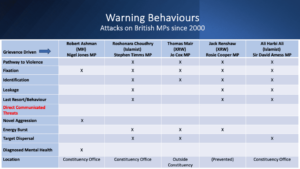Because neither the target nor the security professional knows what to look for.
Marianna Spring, who hosts the podcast “Marianna in Conspiracyland,” said that 80% of the online hate directed at BBC journalists targets her specifically.
The BBC uses software that flags messages containing threats or online violence. Of 14,488 items, 11,771 were directed at Spring.
Now, do you suppose that the BBC has analysed every one of those 14488 messages, or do you think that AI has done that for them?
Are they looking for hate or threats?
The reason I ask is that they are very different things. People are very public about communicating hate, some even believe it’s their ‘human right’ to be allowed to express themselves like that.
Threats however are quite different. It isn’t as simple as saying ‘people who make threats don’t pose threats’ although that is a strong indicator.
For instance, people who make threats and have previously been in an intimate relationship with the person they are threatening very often carry their threats out.
At least 5% of people who communicate a direct threat to a public figure do carry out their threat.
The problem with relying on AI and untrained analysts is that communicating hate and making threats are very low-bar activities when assessing the likelihood of that person posing a threat. The AI may recognise abuse and even hate but is unlikely to recognise a real threat. What often happens is that a person who communicates abuse, hate or threats gets banned or blocked. Any escalation is their behaviour or indication of what they are now doing offline is then missed.
In essence, you will be inundated with, in the BBC’s case, thousands of false positives., draining resources and almost certainly missing the real threats.
Identifying, assessing, and managing threats is a specialism.
Those trained in the science behind behavioural threat management know and recognise the 8 proximal or pre-attack indicators. They understand what the triggers are and the behaviours of concern. They understand how to recognise linguistic-based threats and when a person of concern is escalating.
The fact is that if you don’t know what you are looking for, no level of expertise in research or AI will find it. It is more likely that any such indicators will be ignored as being insignificant….when they are the complete opposite
For further details of our CPD recognised training in advanced behavioural threat assessment and management training contact us directly.



